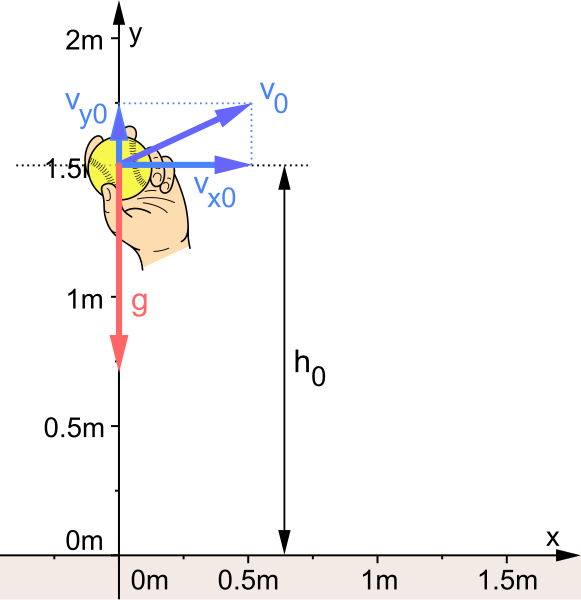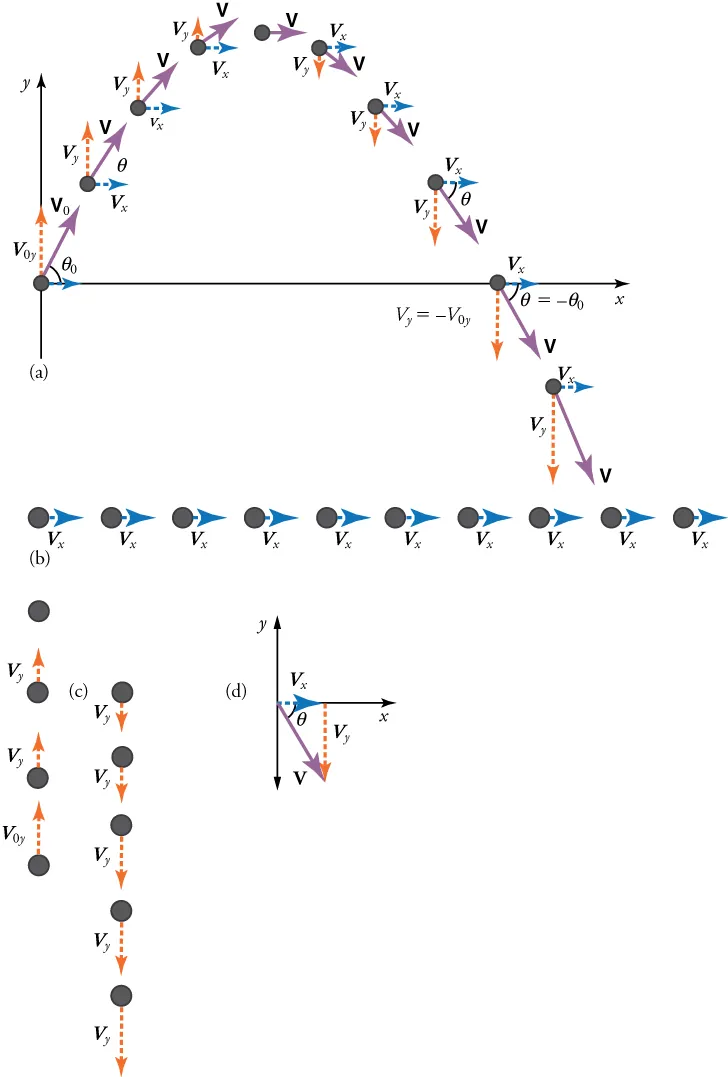OCR Specification focus:
‘Treat projectile motion as independent horizontal and vertical components of motion.’
Projectile motion describes the curved path followed by an object that moves through the air under the influence of gravity alone. Understanding how horizontal and vertical components operate independently is essential for analysing two-dimensional motion and predicting an object’s position at any point in time.
The Nature of Projectile Motion
A projectile is any object that is given an initial velocity and then moves freely under the influence of gravity. Once in motion, the only significant force acting on the projectile (in idealised conditions) is weight, due to gravity. Ignoring air resistance, this force acts vertically downwards and produces a constant vertical acceleration. The horizontal motion remains unaffected by gravity and continues at constant velocity.
The path traced by a projectile is known as a trajectory, and it takes the shape of a parabola. To analyse this motion accurately, it must be resolved into two separate components that can be studied independently.
Independence of Horizontal and Vertical Motion
The key principle of this subtopic is that the horizontal and vertical components of projectile motion are independent of one another. This means that:
The horizontal velocity does not influence how quickly the projectile accelerates downward.
The vertical acceleration (caused by gravity) does not alter the horizontal velocity.
Both motions occur simultaneously, but the governing equations for each direction are distinct
This independence allows students to apply one-dimensional kinematic equations separately along each axis when analysing motion.
Resolving the Motion into Components
When a projectile is launched with an initial velocity v at an angle θ to the horizontal, it can be broken down into two components:
Horizontal component (vₓ) – the velocity parallel to the ground.
Vertical component (vᵧ) – the velocity perpendicular to the ground.

Projectile in an x–y coordinate system with the weight acting vertically. This is the standard frame for treating horizontal motion at constant velocity and vertical motion at constant acceleration. The image is intentionally minimal and does not include extra detail beyond syllabus needs. Source.
EQUATION
—-----------------------------------------------------------------
Horizontal velocity (vₓ) = v cos θ
vₓ = constant horizontal velocity (m s⁻¹)
v = initial launch velocity (m s⁻¹)
θ = launch angle (degrees or radians)
—-----------------------------------------------------------------
EQUATION
—-----------------------------------------------------------------
Vertical velocity (vᵧ) = v sin θ
vᵧ = initial vertical velocity (m s⁻¹)
v = initial launch velocity (m s⁻¹)
θ = launch angle (degrees or radians)
—-----------------------------------------------------------------
Once the velocity components are determined, they can be analysed independently using the equations of motion.

Labeled trajectory illustrating independent components of velocity: vₓ remains constant while vᵧ decreases on the way up, is zero at the apex, and increases downward. The diagram also recombines components to the resultant v. The content aligns with the model of negligible air resistance and uniform g. Source.
The horizontal motion is uniform, while the vertical motion is uniformly accelerated.
Horizontal Motion
In the absence of air resistance, no horizontal force acts on the projectile once it has been launched. Therefore, there is no horizontal acceleration, and the horizontal velocity remains constant throughout the flight.
EQUATION
—-----------------------------------------------------------------
Horizontal displacement (sₓ) = vₓ t
sₓ = horizontal displacement (m)
vₓ = constant horizontal velocity (m s⁻¹)
t = time of flight (s)
—-----------------------------------------------------------------
This equation shows that horizontal displacement depends only on the constant horizontal velocity and the time the projectile remains in the air.
Vertical Motion
The vertical component of motion behaves like any other case of motion under constant acceleration due to gravity. The acceleration is directed downwards and has a magnitude g ≈ 9.81 m s⁻² near the Earth’s surface.
EQUATION
—-----------------------------------------------------------------
Vertical displacement (sᵧ) = vᵧ t − ½ g t²
sᵧ = vertical displacement (m)
vᵧ = initial vertical velocity (m s⁻¹)
g = acceleration due to gravity (9.81 m s⁻²)
t = time elapsed (s)
—-----------------------------------------------------------------
This equation reveals how the upward velocity gradually decreases under the influence of gravity, becoming zero at the maximum height, and then increases downward as the projectile falls.
Key Features of Projectile Motion
Understanding the distinct roles of horizontal and vertical components enables accurate interpretation of a projectile’s behaviour:
Horizontal motion: uniform, constant speed, zero acceleration.
Vertical motion: uniformly accelerated, due to constant g.
Time of flight: determined entirely by the vertical motion; both ascent and descent take equal times if the launch and landing heights are the same.
Range: the total horizontal distance travelled depends on horizontal velocity and total flight time.
Maximum height: reached when the vertical velocity momentarily becomes zero.
These features show that while the motions are independent, they are linked by time — both components share the same duration of motion.
Analysing Motion Graphically
Graphical representations can aid conceptual understanding:
A displacement–time graph for vertical motion shows a symmetric rise and fall.
A velocity–time graph for vertical motion is a straight line with negative gradient equal to −g.
A horizontal displacement–time graph is a straight line with positive constant gradient.
Because the horizontal motion is uniform, the overall two-dimensional path produced by combining these independent graphs is a parabola, a classic signature of projectile motion.
Practical Interpretation and Modelling Assumptions
For OCR A-Level Physics, it is vital to remember that this independence relies on simplified modelling assumptions:
Air resistance is negligible, meaning no horizontal deceleration.
The acceleration due to gravity (g) is constant and uniform.
The projectile is treated as a point mass, ignoring rotation or shape effects.
While these assumptions make analysis straightforward, they are only approximations of real-world conditions. In actual motion, air resistance and variations in g can cause noticeable deviations from ideal predictions.
Experimental Context
In a laboratory, students can explore the independence of components using projectile launchers or data-loggers to record the path of a small object such as a steel ball. By measuring the horizontal range and time of flight, it is possible to confirm that:
The horizontal velocity remains constant.
The vertical acceleration matches g.
Such experiments reinforce the theoretical concept that the two components act independently but occur simultaneously, combining to form the curved trajectory observed.
FAQ
The parabolic shape arises because the horizontal motion has constant velocity, while the vertical motion has constant acceleration due to gravity.
At each moment, the projectile moves horizontally the same distance in equal time intervals, but the vertical displacement increases quadratically with time. When these two motions combine, the resulting trajectory is a parabola.
This relationship holds only when air resistance is negligible and gravitational acceleration is uniform.
For a fixed launch speed, the range depends on the angle of projection.
Maximum range occurs at 45° when launch and landing heights are equal.
Angles smaller than 45° give a lower, shorter trajectory.
Angles greater than 45° produce a higher, shorter path because the vertical component increases but the horizontal component decreases.
If the launch and landing heights differ, the optimum angle is slightly less than 45°.
Air resistance couples the horizontal and vertical components because drag acts opposite to the resultant velocity, not along a single axis.
This means:
The horizontal speed decreases throughout the flight.
The vertical acceleration is no longer constant, as drag reduces the downward acceleration during descent.
Therefore, the independence assumption is no longer valid in real conditions with significant air resistance.
Time of flight depends on how long the projectile remains in the air, which is governed by its vertical displacement and velocity.
The object rises until the vertical velocity becomes zero, then falls back under gravity. The total time can be found from vertical motion equations since horizontal velocity does not influence when the projectile hits the ground.
Thus, even though horizontal motion continues uniformly, it does not affect how long the projectile stays airborne.
Because horizontal and vertical motions can be studied separately, experiments become simpler and more accurate.
In practice:
Horizontal velocity can be measured using timing devices like light gates or video tracking.
Vertical motion can be analysed using the known acceleration due to gravity, g = 9.81 m s⁻².
By collecting data for each direction independently, students can verify theoretical predictions and confirm that horizontal velocity remains constant while vertical motion accelerates.
Practice Questions
Question 1 (2 marks)
A ball is projected horizontally from the top of a 25 m high cliff with a velocity of 8.0 m s⁻¹.
(a) State whether the horizontal and vertical components of the ball’s motion are dependent or independent of each other.
(b) Explain your answer briefly.
Mark scheme:
(a) Independent of each other – 1 mark
(b) Horizontal velocity is unaffected by gravity while vertical motion is accelerated by gravity – 1 mark
Question 2 (5 marks)
A stone is launched with a velocity of 15 m s⁻¹ at an angle of 40° above the horizontal.
Assume there is no air resistance and that g = 9.8 m s⁻².
(a) Calculate the horizontal and vertical components of the stone’s initial velocity. (2 marks)
(b) Explain why the horizontal component of velocity remains constant while the vertical component changes during the flight. (2 marks)
(c) State one modelling assumption made in this analysis and describe how it affects the accuracy of predictions. (1 mark)
Mark scheme:
(a)
Horizontal component vₓ = 15 cos 40° = 11.5 m s⁻¹ – 1 mark
Vertical component vᵧ = 15 sin 40° = 9.6 m s⁻¹ – 1 mark
(b)
Horizontal component remains constant because no horizontal force acts (air resistance neglected) – 1 mark
Vertical component changes because gravity provides a constant downward acceleration g – 1 mark
(c)
Assumption: air resistance is negligible – 1 mark
Explanation: ignoring air resistance causes predicted range and time of flight to be greater than in real conditions.

